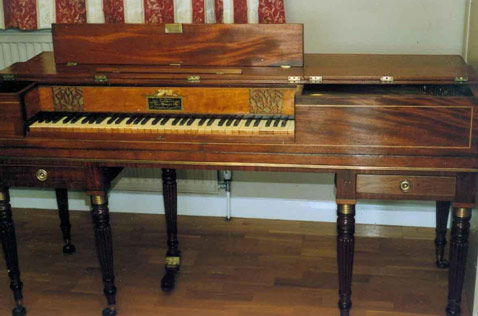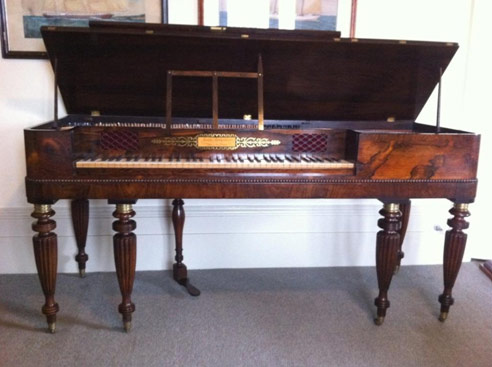Between 1785 and about 1810, many pianos were made with various combinations of the „old‟ (single action, lever-dampers with whalebone springs) and the „new‟ (escapement or „double‟ action and Irish dampers). Patent restrictions were part of this story, but there were many agreements, infringements, and lawsuits! By 1807, Broadwood pianos adopted both innovations, but it is notable that Broadwoods never had nameboard paintings. About this time, six turned legs became usual, replacing the French stand, as on this Clementi.

Gilt-brass collars, casters, paterae, and other embellishments were also available as we enter the Regency period. These are perhaps the most showy of all square pianos. The compass was also extended to six octaves somewhere around 1815, although it was not usual until ten years later. The fine piano below, made by Tomkison in the 1820s, is remarkable in having a compass of 6½ octaves. Note also the use of Rosewood, not only for the nameboard but for the whole case of this very special instrument. Rosewood was, however, usual for nameboards after the early 1820s: compare this with the lighter treatment of the earlier pianos, with their sycamore or satinwood nameboards.

We often consider this rather sombre, dark-toned fashion to be „Victorian‟, but it is worth noting that fashion was moving in this direction at least fifteen years before Victoria‟s accession.
Moving on a few years, the Broadwood below is typical of what for many of us was our first square piano. It dates from about 1830, when Broadwood‟s dominance of the market was at its height. This one has an iron string-plate and strengthening bar, and the usual six-octave keyboard. Such pianos turn up quite often in good condition and at very reasonable prices, because there were a lot of them in the first place, and they are more robust and reliable than earlier types.

The final example in this short history is another Broadwood (below) made in 1854, and a fine example of the very last English Square Pianos.

This one is again in rosewood, and has a compass of nearly seven octaves – almost the same as a modern piano. These handsome instruments have a splendid tone, but they are large and heavy. The very first „cottage‟ upright pianos had appeared around 1800, but they took some years to establish themselves. However, by about 1850, they had become the usual domestic instrument. This Broadwood square was made in 1854, and took up considerably more floor-space than an upright: it was also more expensive. The square was now caught between the upright and the grand, and gradually declined in popularity. Very few were made after 1860, and the very last English square was delivered by Broadwoods in 1866. |
